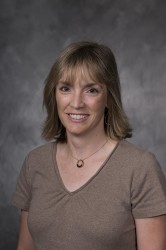Even for Drake professors, learning is never done. Sandy Henry, assistant professor of advertising, will soon have a whole new set of tools and knowledge to share with her students come fall.

Henry is one of 35 people who will attend the Time Warner College Professors Thought Leadership Seminar in New York City. The seminar’s participants were chosen through a selective application process. Only members of the Broadcast Education Association (BEA) were eligible to apply.
Participants will learn about the latest technology and advances in media research at the brand new Time Warner MediaLab during the seminar. They will also explore the possibilities the new technology and research offer. The MediaLab is a state-of-the-art facility that gives Time Warner and its key partners the means to understand consumer behavior across the advertising content spectrum, from print and online advertising to point-of-sale promotions.
Henry had more than 20 years of experience in advertising and marketing—both in agencies and in-house environments—before joining the School of Journalism and Mass Communication faculty. Her clients covered a wide range, from a major grocery store chain, to a nonprofit arts organization, to one of the world’s largest agricultural seed companies. Henry has won many awards for her work, including Addys, Tellys, National Agri-Marketing Association Awards, and Council for Advancement and Support of Education Awards.
While Henry has a plethora of expertise in the field of advertising, she is excited to be one of a handful of outside professionals to experience the lab.
“This facility has only been open for a few months, so this will give me knowledge about something few people have seen,” Henry says. “Being able to teach my students about the latest and greatest techniques in media research will, in turn, hopefully give them knowledge that few others have.”
Executives who designed and use the technology will lead discussions throughout the seminar and will educate professors about how consumers engage with content. Participants will experience “hands-on” testing with the latest in devices and distribution platforms.
Along with the seminar, Henry is very excited about the facility itself.
“It is a fantastic combination of research and technology,” she says.
The 9,600 square-foot MediaLab features an in-home simulation room, theater, eye-tracking room, and retail checkout. It also features a usability lab and conversation room with observation areas for numerous parts of the MediaLab.
This technology may hold the solution for a slew of advertising challenges. One issue Henry hopes to address is the process of creating an advertising plan that is effective and will produce successful and measureable results. Henry says she often wonders how her students will measure the viability of various tactics.
One of the tools Henry is most intrigued by is the eye-tracking room. The room contains a 64-inch plasma TV and a PC monitor as well as the eye-tracking device itself, which can follow a person’s eye movements when viewing websites, TV, or mobile content to determine what draws the eye and what is ignored. The real-time collection of consumers’ visual behavior allows for immediate adjustments to design and tactics.
In addition to technology, MediaLab researchers will look to other areas for research, such as social media. Henry knows that research will be beneficial to her students.
“The Fall TV schedule is a good example of imprecise market research,” Henry says, explaining how the MediaLab could be used in a real-world scenario. “Even though all of these market research groups do research before the shows air, a lot of TV shows still end up failing.”
Through research and testing in the MediaLab, this imprecise branch of marketing can be greatly improved.
Henry is eager for the chance to share this opportunity with her students.
“Any time I can come into the classroom and give my students a first-person account of what’s going on in the industry, that benefits them,” Henry says. “Since advertising is based on understanding how to connect with the target audience, and this research facility is dedicated to that understanding, I’m sure it will have an impact on everything I teach.”
Visit http://www.timewarnermedialab.com/ to view a virtual tour of the Time Warner MediaLab.

